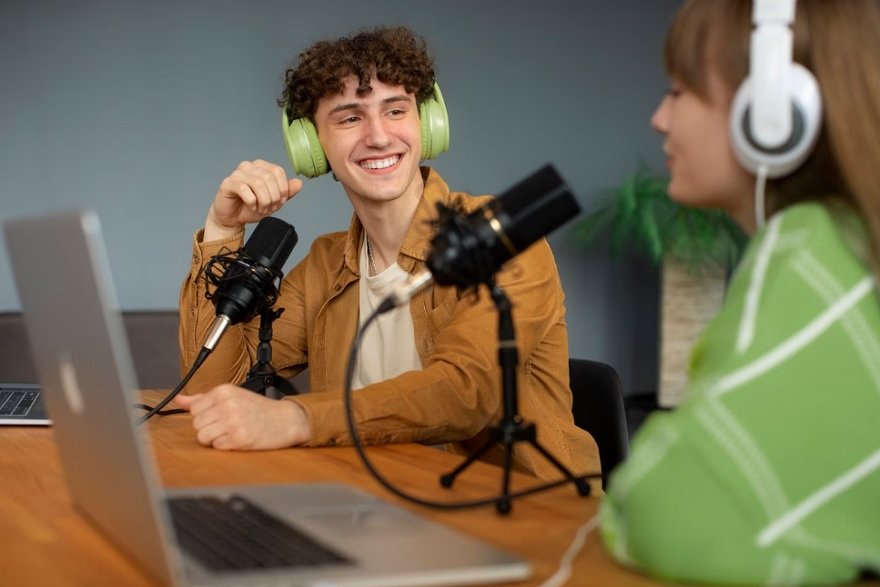From TikTok to Instagram: How Social Media is Redefining the Entertainment Landscape
Social media has fundamentally changed how we discover, consume, and engage with entertainment content. Platforms like TikTok and Instagram have revolutionized the entertainment world by empowering creators, fostering viral trends, and allowing anyone to become a part of popular culture. In this evolving landscape, social media is redefining entertainment in ways that offer both opportunities and challenges for industries and consumers alike.
Over the past decade, social media has grown from a novel way to connect with friends to a dominant force in the entertainment industry. Platforms like YouTube and Snapchat first demonstrated how social technology could transform how people create and enjoy entertainment. But over the last few years, TikTok and Instagram have emerged as two of the most influential social platforms shaping entertainment today.
From music and comedy to fashion and film, these apps are changing how entertainment is discovered, consumed, and engaged with. Their rise has challenged traditional entertainment business models while also creating avenues for new voices to be heard. As social media continues to integrate deeper into entertainment, understanding its impact will be key for creators, marketers, and consumers in this space.
The Rise of TikTok
In just a few short years, TikTok has become one of the most downloaded apps in the world. The Chinese video-sharing platform lets users create and share 15-60 second videos spanning genres like comedy, music, and education. It rocketed to mainstream popularity with its addicting feed of short, entertaining video clips.
TikTok distinguishes itself from predecessors like Vine with its sophisticated AI-driven recommendation system. The algorithm learns viewer preferences to serve up a customized feed of engaging content. This creates an experience where users can scroll endlessly as entertaining new videos match their interests.
The app has been downloaded over 3.3 billion times, with users spending an average of 52 minutes per day on the platform. Its growth has been explosive – in 2018, TikTok was the fourth most downloaded app in the world. Today, it consistently ranks among the top two.
TikTok has become a launching pad for viral entertainment that migrates across the internet. Trends like dance challenges, comedy bits, and meme songs often gain traction on TikTok before spreading to other social, streaming, and traditional media. This cultural influence has established TikTok as a taste-maker for what becomes popular entertainment.
The platform has also created a new kind of entertainment celebrity: TikTok stars who build massive audiences through their creative, funny, or informative short videos. 16 year-old dancer Charli D’Amelio rocketed to fame through dance videos, amassing a staggering 142 million TikTok followers. Comedians like Khaby Lame and everyday creators like Tabitha Brown also built huge fanbases from TikTok content.
Brands have taken notice, flocking to sponsorships, influencer campaigns, and organic content creation on the app. Jimmy Fallon, Tyler Perry, and major sports leagues have established official TikTok accounts to connect with younger audiences. With its growing cultural dominance and diverse new talent, TikTok has become essential for marketers in the entertainment space today.
Instagram’s Response: The Emergence of Reels
Instagram has long been a favorite platform for sharing photos and videos. But with TikTok’s meteoric rise threatening to siphon younger users, Instagram responded with the 2020 launch of Reels – its own short-form video feature.
Reels allows users to create 15-second multi-clip videos enhanced with audio, effects and creative editing tools. The TikTok-inspired functionality sits prominently on Instagram’s home page, aiming to bring the same engaging, scrolling video experience to its broader user base.
Early reception of Reels has been positive, with many influencers and brands embracing the new creative outlet. In particular, Reels provides celebrities and public figures an easy way to join viral trends and challenges within the familiar Instagram ecosystem.
And much like TikTok, Instagram is making Reels integral to its recommendation algorithms. The platform aims to surface popular Reels the same way it promotes Stories and live content, maximizing reach for entertaining videos.
However, Reels faces a major challenge in competing with TikTok’s dominance as the destination for short video entertainment. While active Reels users are growing steadily, usage still pales in comparison to TikTok. And as a mature, photo-driven platform, Instagram may have difficulty steering its broader user base towards Reels’ video features.
Still, Reels offers entertainment creators and brands a massive new stage with Instagram’s one billion monthly active users. Its seamless integration with Instagram Stories and the Explore page give it natural visibility advantages. As Instagram continues refining Reels, it could become a major competitor in social video – and entertainment more broadly – in the years ahead.
The Democratization of Content Creation
A core way social media is transforming entertainment is by democratizing who can build an audience and create popular content. In the past, creating entertainment required specialized skills, equipment, and access to distribution channels. But today, anyone with a phone and creative vision can make their mark.
Platforms like TikTok and Instagram let users easily shoot, edit, and post content instantaneously from their mobile device. Built-in editing tools, background music, visual effects, and more allow creators to develop high-quality content from scratch. And these platforms handle hosting and distribution – delivering content straight to mass audiences hungry for engaging experiences.
This low barrier to entry has diversified entertainment by letting previously unheard voices emerge. Young creators, niche subcultures, and underrepresented communities can share stories and perspectives that may have never broken through in mainstream entertainment.
29 year-old Nathan Apodaca skyrocketed to fame after posting a relaxed video of himself skateboarding and drinking cranberry juice on TikTok. The unpolished clip quickly went viral for its authentic vibe often missing in curated social media. Creators like Apodaca gain opportunities ranging from TV appearances to sponsorship deals by resonating in the unfiltered social media landscape.
Still, challenges remain in helping diverse creators build sustainable careers from rising social media fame. But by giving anyone a platform, social media brings fresh, ground-up entertainment unique to these communities. The variety and volume of social content represents a democratization of entertainment the industry is still grappling to understand.
The Role of Influencers in Shaping Entertainment Trends
The rise of social media has also given birth to a new type of internet celebrity: influencers. These are creators who build massive, loyal audiences around their public persona, expertise, or content.
Influencers have become tastemakers who shape trends, drive buzz, and keep their niche engaged. Top influencers like MrBeast, Charli D’Amelio and Addison Rae command the attention of tens of millions of followers. Fans passionately tune in for their content while brands eagerly sponsor them in hopes of benefiting from their sway.
The influencer economy was pioneered on YouTube and Instagram, but TikTok has recently become a breeding ground for launching influencer careers. Young stars grow colossal fanbases from viral TikTok moments that capture the zeitgeist. The humble lifestyles portrayed in many top TikToks lend them an authenticity that attracts loyal, engaged followers.
These TikTok influencers hold major appeal for brands in driving awareness and engagement. Partnerships typically involve sponsorships, product integrations, and influencers promoting brands through organic content. Recent examples include Charli D’Amelio starring in a Hollister campaign and TikToker Bella Poarch promoting products from Spin Master.
Well-matched influencer campaigns generate win-win value for brands and creators alike. And as TikTok stars continue entering pop culture, brands have an opportunity to tap their marketing influence early while expanding their own entertainment footprint.
Beyond direct promotions, influencers also indirectly shape entertainment trends through their viral content. Dance challenges, comedic sketches, and music memes flow from top personalities for followers to recreate and riff on. As these trends spread across social media, influencers leave an imprint on broader entertainment culture.
The Challenges and Opportunities Presented by Social Media
While bringing clear opportunities, social media also raises concerns that the entertainment industry is still working through. Issues around ethics, misinformation, and disruption of traditional business models present real challenges.
On the ethical front, questions persist around privacy, safety for child creators, and authenticity in an influencer marketplace saturated with sponsorship opportunities. Moderating bullying and misinformation also remains an uphill battle, as apps aim to balance free speech with user protection.
More broadly, industry disruption has left many traditional entertainment businesses scrambling for their place. Movie theaters and live venues face declining ticket sales as on-demand streaming soars. Record labels and studios are still adapting to subscription and piracy challenges stemming from the digital revolution.
But opportunities for traditional players also exist to leverage social media rather than compete with it. Studios integrate viral songs into movie soundtracks and license clips as promotional materials. Late night shows clip segments for social distribution rather than forcing youth audiences toward linear TV. Sports leagues ride viral moments like courtside memes to bolster cultural resonance.
Rather than a disruption, current trends point to a convergence – where traditional entertainment taps the strengths of social platforms for greater connectivity with audiences. This integration will be key as home screen entertainment powered by TikTok and Instagram becomes an increasingly critical part of the business.
The impact also goes beyond industry economics to fundamentally change entertainment habits and tastes. Shorter attention spans gravitate toward digestible content. Viewers increasingly expect interactivity whether through voting mechanisms, social engagements or live streams.
Social platforms have accelerated these shifts, training broader audiences to expect always-on immersion. Rather than distinct activities, entertainment is now omnipresent; an endless stream of engaging moments as close as one’s mobile screen.
Conclusion
In many ways, social media has brought entertainment back to its roots of connecting people through shared experiences and emotions. But while the stage looks familiar, the players, business models and technologies are new.
TikTok and Instagram now sit alongside Hollywood and Nashville in dictating entertainment trends. Influencers shape pop culture in the same breath as A-list celebrities. Amateur creators distribute to audiences as seamlessly as major studios.
This redefined landscape will continue taking shape as emerging platforms enhance immersive engagement and traditional players adapt to new distribution channels. How will virtual reality expand social media escapism? What does the Metaverse mean for concerts, conventions and interactive storytelling?
One certainty is that entertainment will only grow more personal, responsive and integrated into daily habits. And understanding this evolution will be critical for creators, brands and consumers looking to cut through the noise.
The stage is set for social media to drive an entertainment revolution. For those passionate about influencing culture: the opportunity is yours to seize. The only question now is how you will use these powerful platforms to shape the future of entertainment.






